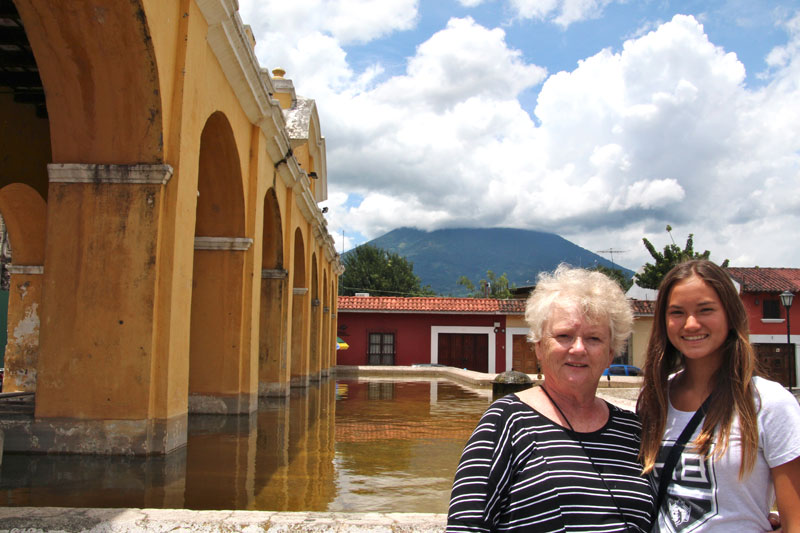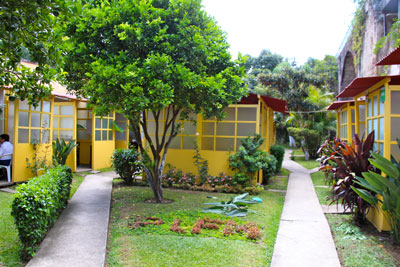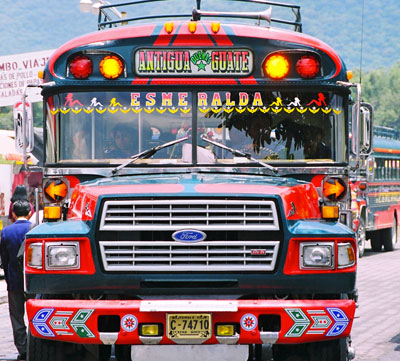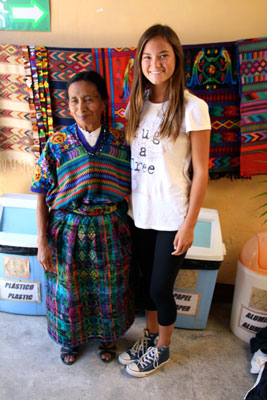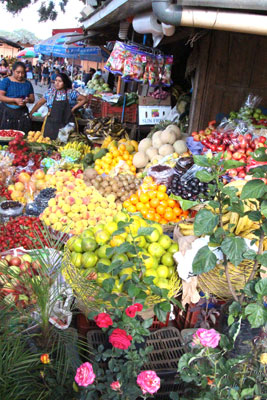Two generations on a language-study jaunt to Guatemala
This article appears on page 34 of the December 2014 issue.
Could a 14-year-old girl find happiness taking Spanish lessons in Guatemala with her 75-year-old grandparents? We hoped so!
Making plans
Our granddaughter, PJ, was graduating from middle school, and my wife, Rosie, and I realized that, given her increasingly busy schedule, we had better offer her a trip sooner rather than later. So for the summer of 2014, we gave her a choice of trips: to Williamsburg, Virginia, to see American colonial life or to Antigua, Guatemala, to study Spanish and learn about the country’s culture.
After some hesitation (she expressed a bit of concern about being in a one-on-one Spanish class for four hours a day), PJ opted for Guatemala, partly because she had developed an interest in Spanish after a year of taking it in school and partly out of a sense of adventure. Her summer schedule limited us to one week.
Rosie and I have been to Guatemala 15 to 20 times, beginning in 1994 with a 6-week one-on-one Spanish program, and we have grown to appreciate its people and culture.
After PJ’s acceptance of our proposal, we faced a variety of questions. Could we ensure her personal safety and health? Would she become homesick (or sick of eight days with the idiosyncrasies of two 75-year-olds)? Would culture shock overwhelm her, or would she find being in Guatemala and taking Spanish lessons to be stimulating and fun?
Despite the reputation that Guatemala has for being a crime-ridden country, much of it — especially Antigua, with its special tourist police force — remains relatively safe for travelers as long as they take the normal precautions, including taking a taxi or tuk-tuk to their destination, not walking alone at night and keeping a mindful watch on their belongings. (The safety of riding in a tuk-tuk is another matter….)
In response to our questions about possible health concerns, our son and daughter-in-law provided us with PJ’s medical insurance card and an authorization for us to make any emergency medical decisions.
For this trip, we rented a 3-bedroom house ($800 for a week) instead of staying in a hotel or with a family. It provided greater privacy than a hotel or homestay, and with a kitchen we could eat breakfast and prepare an occasional lunch. We also had the convenience of being located five blocks from the central park and, in another direction, five blocks from the school we would be attending.
Our house came equipped with a TV (never used), board games, for some friendly evening competition, and Wi-Fi, which enabled PJ to stay in touch with her family and friends via messages and photos.
An especially delightful perk of this rental was that the Guatemalan woman who looked after the house for its Norteamericano owners would shop each day for us, delivering tortillas, tamales and paches (similar to corn tamales but made with potatoes).
Spanish lessons
For Spanish lessons, we attended Proyecto Lingüístico Francisco Marroquín, or PLFM (6 Avenida Norte No. 43; phone 800/552-2051, www.spanishschoolplfm.com/sitio), the oldest and one of the most well-respected programs out of the 50 or so Spanish-language schools located in Antigua. (See www.
guatemala365.com for a survey of 30 of the schools.)
Its facility, located near La Merced Church, north of the Parque Central, can accommodate nearly 90 students (although there were only 15 during the week we were there) and includes separate open-air booths, each with a desk and chairs, that open up onto verdant gardens, plus clean restrooms. Complimentary tea, coffee and filtered water are available to the students.
As do most of the language schools in Guatemala, Marroquín offers an immersion program in which students each work one on one with a teacher for seven hours ($200 per week) or, as we chose, four hours per day ($150 per week).
The school offers a low-cost housing option of living with a family whose accommodations and offered meals have been prescreened. (We’d lived with a family on prior trips and found it to be an excellent opportunity to practice Spanish and experience Guatemalan life up close.)
Antigua has several excellent language schools. Over the years we had attended three or four, and we selected Marroquín for this trip because of our earlier positive experiences there.
The quality of instruction and the classroom setting in the lush gardens of a colonial building impressed us, as did the broad range of ages and backgrounds of the students it attracted, including government, NGO and religious workers needing to learn Spanish for their work, as well as US and European college students and backpackers and Spanish aficionados.
Before we made our school decision, Rosie contacted a few schools and indicated that we would be attending with our granddaughter and asked about their teaching methods for younger students. The director of Marroquín assured her that they could accommodate the needs of a 14-year-old with one year of middle-school Spanish. (The week prior to our attending, the school had 30 teenagers from northern California.)
PJ’s teacher, a warm and supportive woman with two preteens of her own, combined each morning with conversation, grammar drills and numerous games. By the middle of the week, PJ had become comfortable enough with her Spanish to order food in restaurants, bargain in shops and engage in a few mini conversations in Spanish.
While one does not learn a language in four hours per day over five days, from my experience and from observing PJ, it seems to stimulate interest in improving one’s Spanish skills. Discovering that a stranger actually understands you and responds accordingly clearly boosts confidence.
Cultural experiences
We had hoped to provide PJ with a glimpse of a culture that was significantly different from what she had experienced in southern California or on family trips to Hawaii, Fiji and Costa Rica. However, spending only one week in Guatemala while going to school half of each day severely limits the amount of time one can spend exploring its indigenous cultures, markets, textiles, colonial architecture, ruins and arts-and-crafts museums — and, of course, shopping.
Each afternoon, following our Spanish lessons, we would traipse about the streets of Antigua poking around in shops, ruins and other sites.
We were able to include an all-day trip to Chichicastenango to visit the Sunday market, the largest market in Guatemala. The Hermosa Beach, California, farmer’s market, where PJ and her friends would meet on Fridays after school, is a mere shadow of Chichi, with its throngs of locals in their bright and finely woven local dress carrying packages on their heads or shoulders, showing off wares, pushing and bargaining, all in close quarters.
There is also a church where indigenous holy men and women stand in front of the entrance to the sanctuary praying and waving burning incense, while others on the steps below sell flowers, chat or sleep.
The sights and odors of produce and meats not usually found in supermarkets at home contributed to the assault of colors, sounds, smells and people. PJ’s initial response to this was that it gave her a throbbing headache. However, after a week’s reflection, she said this was one of her favorite parts of the trip.
For another cultural adventure, we visited the home of a Mayan family in the village of San Antonio Aqua Calientes, located not far from Antigua. The town is noted for its weavers, and among them is our friend Rafaela Godinez, who has traveled several times to the US to demonstrate the technique of backstrap weaving.
After our visit, we returned to Antigua via “chicken bus,” Guatemala’s main means of mass transport. Old yellow US school buses have been transformed with bright colors, many being adorned with Bible verses and silhouettes of shapely women on the windshields. Usually packed with Guatemalans, often sitting six abreast, the buses are frequently stacked with produce and animals on top. In our bus, the driver had one hand on the horn, and his assistant was hanging out of the front door shouting out the bus’ destination.
Dining in Antigua
Antigua’s numerous restaurants offered a variety of tastes that appealed to an American teenager (as well as to her grandparents), including traditional Guatemalan cuisine as well as Italian, Asian and Californian. While most Guatemalan food is not highly spiced, it still has ingredients and flavors not found in North American fare.
Among our favorite restaurants were Café Condesa (Portal del Comercio 4), located across from Parque Central, for a breakfast; Quesos y Vino (phone 502 7832 7785, www.quesosyvino.com) for pizza and pasta dishes; Sabe Rico (6 A Avenida Sur 7) for sandwiches and salads in its verdant garden; Epicure (3a Avenida Norte No. 11B) for gourmet preparations of tilapia and lasagna, and La Fonda de la Calle Real (www.lafondadelacallereal.com) for traditional Guatemalan food, such as pepián chicken.
At the exquisite Casa Santo Domingo Hotel (3a Calle Oriente No. 28A; www.casasantodomingo.com.gt), built on the former site of a convent, we combined a stop for lunch with a walk through the ruins, tunnels, crypts, ossuaries, art galleries and museums around the grounds.
Our last meal — a hearty brunch accompanied by traditional marimba musicians at La Posada de Don Rodrigo (Calle de Arco No. 17; www.posadadedonrodrigo.com) — proved to be PJ’s favorite restaurant meal.
Besides excellent food and reasonable prices (meals averaged about $50 for the three of us, including wine for the adults at dinner), all but one of these eateries offered inside and outside dining, and most were located among ruins or in old colonial homes and buildings.
All hopes realized
By the end of the week, we felt that PJ had gotten an excellent introduction to Guatemala and a glimpse of a different culture. She seemed to enjoy it and even indicated a desire to return. For the most part, she confirmed our hopes.
Following our return home, when we talked about the highlights of our stay, her favorite memories revolved around the “feeling” and “sense” that she had experienced a different and interesting culture.
In contrast to her original anxieties about going to school, she said, “It was more fun than I had expected,” and mentioned that the school experience — its “pretty environment, the one-on-one teaching style and the teacher” — ranked among the highlights of her trip.
Another highlight for PJ was the food, especially the homemade tamales and paches made by the neighbor and the huevos enfrijolados (similar to huevos rancheros) at Don Rodrigo’s.
She even mentioned that she liked being with her grandparents!
Hopefully, the memory of this trip will be the seed that inspires further curiosity in visiting more of Guatemala.
From our perspective, the trip allowed us to spend a week with our granddaughter by ourselves, to share our love of Guatemala and other cultures and to have an experience with her that may never be replicated. What could be better than that?!

